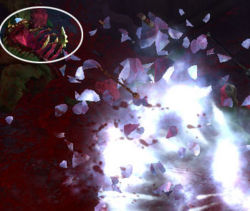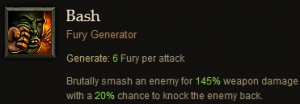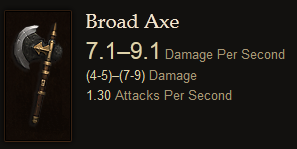Combat
| Beta Content A significant portion of this article deals with development / pre-release / Beta content. A request has been made for it to be updated. List of Beta Content Pages |
Every class in Diablo III is a DPS class; all are capable of prolifically slaying the enemies, whether by spells, skills, brute force, or a clever combination of all three.
Aspects of combat are addressed throughout this wiki. Weapons and skills are detailed, monsters are described, strategies are promoted, and more. This page covers the basics of combat, and how the game is designed to facilitate it, with numerous quotes from the D3 Team. Keep in mind that many of these fundamentals have changed during development, and that full details will not be known until after release.
Contents
Damage Types
As in previous games in the series, there are numerous types of damage in Diablo III. Various spells, skills, runes, and weapons channel their destructive might into one (or more) types of damage. Characters and monsters counter these attacks with equivalent types of resistance and immunities, and players must find the right balance of each if they wish to succeed in their battles.
Damage in Diablo III takes the following forms. Every form of damage can count for a critical hit (caused by various item or skill properties) and when a "crit" is landed, a bonus effect is added along with increased damage. Targets that die to critical hits usually explode in gory and thematically-appropriate fashion.
- Critical hit: Deals double damage.
Arcane Damage: Purple in coloration.
- Critical hit: Arcane crits "silence" targets. (Silenced targets can not cast some spells, such as a Skeletal Summoner or Goatman Shaman resurrecting fallen minions.)
Cold Damage: Blue in coloration.
- Critical hit: Cold crits freeze targets for 2 seconds. (Duration affected by numerous other factors.)
Fire Damage: Red in coloration.
- Critical hit: Fire crits set targets ablaze, adding DoT to the initial fire damage.
Lightning Damage: White in coloration.
- Critical hit: Lightning crits stun targets for 2 seconds. (Duration affected by numerous other factors.)
Disease Damage: Green in coloration. (Formerly known as "Toxic.")
- Critical hit: Disease crits deal an unknown bonus.
- Resisted by Poison resistance.
- Diseased units suffer a damage debuff; they take more damage and deal less.
Poison Damage: Green in coloration. (Also known as Acid.) (Poison and Disease are similar, but not the same.[1])
- Critical hit: Poison crits deal an unknown bonus.
- Resisted by Poison resistance.
- Poisoned units suffer a health debuff; their regeneration and healing is lessened or reversed.
Holy Damage: White in coloration. (Found mostly on Monk skills.) Extra damage to Undead?
- Critical hit: Unknown.
- Resisted by: Unknown.
Damage Over Time
The DoT mechanic is much expanded and complicated in Diablo 3. No longer is the equation simply "X damage per second over Y seconds." In December 2011, Bashiok delivered an informative forum post on the subject, which you can read below:[2]
Spell Damage
The actual formula for spell damage is one of the biggest changes to combat in Diablo III. It's been changed to work much like physical damage does; spells now come with a fairly low base damage, much like weapons, and that value is acted upon by attributes, spells, traits, and equipment bonuses, all of which factor in to the final spell damage. The ratios and relationships in this have changed repeatedly during development, and the final details are not yet finalized.
Early in Diablo III's development, equipment with +%spell damage was said to be of great importance to mage type characters, who were destined to value it as combat characters do +% weapon damage equipment. This system evolved during development, and as of January 2012 such equipment is quite rare in the Beta test, with most +damage now delivered by attributes, especially gear with +Attack stats.
- See the Spell Damage article for full details.
Health Bar
The display of monster health bars has changed repeatedly during development (as has everything in the interface.) As of the beta test, the display of regular monster health bars can be toggled on/off. Only bosses and champions always show their health bars atop the screen, when they are targeted.
Special quest event bosses, such as the Skeleton King or Siegebreaker show their health bars in a special scrollwork frame, in the top center of the screen for the duration of the battle, even if the character is not currently targeting the boss, or even on the screen with them.
Target Outline
One of the surprise controversies of Blizzcon 2009 was the red target outline. A new feature just added to the game was a glowing red outline around the monster being pointed at. This outline was meant to help players identify what they were pointing at on the frequently-crowded and chaotic battle screens of Diablo 3. Most players didn't mind or didn't even notice while playing at the show, but for some at Blizzcon, and for many others viewing screenshots and gameplay movies over the Internet, the red outline was bright and too obvious and distracting.
This became a minor issue of contention, but the D3 Team never wavered in their opinion that the feature was essential.[3] It seems to have been accepted over time, and has been a non issue during the Diablo III beta.
- See the Red Target Outline page for much more on this, including numerous Blue quotes.
Information Through Graphics
The visuals tied to damage types are meant to add eye candy, but also to inform the player about events occurring on the screen. As Julian Love explained during BlizzCast #8, in March 2009. [4]
Critical Hit Visuals
Critical hits inflict extra damage and/or bonus effects (detailed above). Various skills and items can improve the odds of a critical hit, as well as the damage it deals. Other skills or item effects trigger each time a critical hit is scored, creating an interesting and interconnected system of damage bonuses.
Critical hits existed in Diablo II, but they were indicated only by a small sparkle of white light. That concept has been vastly upgraded in Diablo III. Now, when a monster takes a "crit" there's a dramatic graphical effect, especially if the death is due to crits. Monsters so slain literally explode, shattering into gory chunks that fly across the screen and litter the ground. These animations are customized for whatever type of damage killed them; flames will be seen on the hunks of meat if the critical was fire-based, sparks rise from lightning, etc. Physical damage crits leave huge slicks of blood and give a battlefield a lovely post-massacre patina.
- See the critical hits page for much more detail.
In Depth Combat
The combat in Diablo I and Diablo II was often criticized for being simplistic. Not only could most characters "spam" the same one or two skills over and over again, this was actually the best way to play, in most situations. Diablo III is attempting to change this mechanic in various ways, most notably the better balance to skills, the way that skill damage scales up with attributes, and the removal of skill points.
As a general design goal, the D3 Team wants to make combat much more tactical. Diablo III is still a fast-paced, click-intensive Action RPG, but there should be a bit more strategy required than "click 'til dead." Jay Wilson spoke on the shallowness of combat in D2, and his plans to deepen it in D3 with 1up.com in December 2008.
- The combat model doesn't have a lot of depth in the previous games. It was very much a "one-skill spam" kind of game, which I think works great for the Normal [difficulty] playthrough. I think most of the audience is just fine with that, and through most of the Normal difficulty, it's going to be like that. But as you go into Nightmare and Hell difficulties, I think that the more serious player will appreciate a game that's a little deeper on the combat-mechanic side.
- 1up.com: What makes Diablo 3's combat deeper than its predecessors?
- Jay Wilson: Combat is as deep as the options the designers give themselves. Whenever you add a new capability to a monster -- potentially something that feels unbeatable -- it's more of an opportunity to expand the depth of your characters so they can respond to those threats. A good example would be if you look at Diablo 2: There were a couple of problems with just the power of the characters and the way they were made powerful. A player could run faster than any monster, so you could escape just about any threat. You had endless health and resource -- by resource, I mean mana -- because of potions. And you had the Town Portal, which could instantly get you out of any problem. Those were incredibly powerful mechanics to escape danger and were not class-specific. So every kind of class really had no need for anything like an escape skill or reactionary ability. They simply needed to attack, and if they ever got in over their heads, they simply ran away or drank potions. And it's the same response across the board.
- 1up.com: What makes Diablo 3's combat deeper than its predecessors?
- So one of the things we focused on is that response -- 1) setting up scenarios where the players can't easily get out of danger without the use of class-specific skills, and 2) giving them really simple controls to use a broader range of skills without making the game that much more complex to play. I really distinguish the difference between complexity and depth; to me, complexity is adding more buttons, while depth is making a single button more powerful and versatile. So that's always been our goal -- reducing the amount of controls while making each button mean more. So that's one of the reasons we added the Hotbar; it's one of the reasons why we avoided the potion-health system. And when people play the game, they may not notice this next point that much, but we leveled out the movement speed somewhat so that the player moves at a more reasonable rate compared to the monsters.
Most of Jay's design goals from 2008 are evident in the finished game, though changes like the removal of town portals, much slower character foot speed, long cooldowns after using health potions, and more.
The disincentives to spamming the same skill over and over again are not very visible in the beta test, such things are not meant to come strongly into play until higher difficulty levels
Weapon Damage on Skills
The damage of all skills and spells in Diablo III are determined by a character's attributes (chiefly Attack) and their weapon damage. This include spells, such as Magic Missile, Poison Dart, and all the rest. This change equalizes equipment needs, as now mage classes need to hunt for big damage weapons just as combat classes always have.
Casting speed is also affected by weapon choice, just as attack speed always has been. As a result a Wizard or Witch Doctor can use a large two-handed weapon, and their spell damage will increase, but they will generally suffer a much slower casting rate as a result. The more appropriate mage weapons, such as wands for Wizards and daggers for Witch Doctors, also tend to have appropriate bonus stats, such as + to their resource regen rates, that will never spawn on combat weapons.
Off-hand weapons are another important factor. Wizards can use Orbs, Witch Doctors can use Totems, and Demon Hunters can use Quivers, all in their off-hand slot along with a regular weapon. These off hand items tend to spawn with very useful bonuses, and as a result a Wizard with a good Orb and a good Wand will almost always do more damage than the same Wizard with a big damage two-handed weapon. Plus the Wand and Orb will have more useful bonuses.
How well this ratio will balance out in the late game is unknown, but as of the beta, a Wizard or Witch Doctor is always better off with a one-handed weapon and their class-specific off-hand item than they would be with any available two-handed weapon.
Skill Modifiers for "on Hit" stats
Items can often have a stat "on Hit" that is applied every time you hit with that skill. Because the speeds and number of enemies hit with each skill are different, Blizzard implemented a modifier to each skill. For example, Life on Hit +20 will not yield exactly 20 life on most skills. A list of skills and their modifiers can be found here: On Hit Modifiers.
Dual wielding and Weapon Damage when using Skills
When a dual-wielding character performs a skill that is based on % weapon damage, the character will alternate hits with the two equipped weapons. Unlike Diablo 2, Diablo 3 is smart enough to calculate everything individually, bonuses aren't simply added up between two weapons and applied equally with either one.
Damage Over Time, for instance, is calculated individually by whichever weapon delivered the hit, with the "tick rate" of the DoT determined by the attack speed of the weapon that delivered it. Earlier in D3's development, dual wielding was said to grant an inherent bonus to attack speed, but this feature can not be discerned in the beta test.
| Items of Diablo III [e] Item Basics Normal Items Crafting Legendary Armor I Legendary Armor II Legendary Weapons 1h Legendary Weapons 2h Item Sets |
|---|






